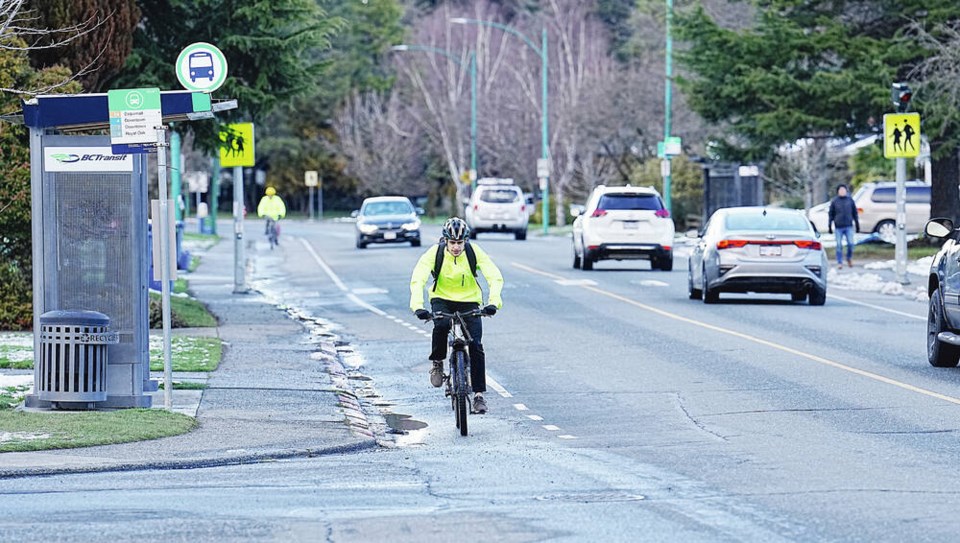It’s important to keep reminding people about the increased risks around road safety as we move deep into the fall season and daylight dwindles.
It’s especially important for cyclists and drivers to be aware of each other when visibility decreases and where reaction times are affected by wind, rain and general cruddiness of the weather at this time of year.
Drivers must realize that cyclists have a right to be on our roads just as much as any other vehicle. New laws are coming into effect in B.C. that categorize them as “vulnerable road users.” This is an effort to ensure the cyclist has fair use to our roadways while factoring in the enormous weight and size difference they offer against cars and trucks.
At the same time, it’s well established in B.C. law that cyclists have the same duties and responsibilities as vehicle operators. Cyclists should abide by those principles at all times because, as I’ve written many times, being “dead” right in a conflict with a vehicle is a mug’s game.
For the cyclist, visibility is probably the most important part of staying safe on the road during the fall. It starts with effective, working lights on the bike itself, although I draw the line at those mega flashing strobes which blind other road users.
Reflective clothing is equally important. There’s some amazing gear out there now that can not only keep a rider dry but can be spotted blocks away by vehicle drivers even on the dirtiest nights.
A black jacket is neither reflective nor visible. Why can’t some riders figure that out?
Just like cars, brakes on bikes are less effective when they are wet. It’s important to leave yourself manoeuvring room and more distance in bad weather. I see at least one cyclist go down on the Esquimalt Road railway crossing every year — always during bad weather.
It’s often tempting in bad weather — but stay off the sidewalk. For one it’s illegal and studies show that there is a much greater chance of collisions with vehicles when you suddenly appear from a space where you’re not supposed to be.
Finally, avoid puddles if possible. It’s an assumption that the one in front of you is just a shallow pool of water. Oftentimes it’s a deep crater capable of bending a wheel rim or flipping you head over heels on a busy street.
On the vehicle side, drivers have to accept that we are moving steadily into a cycling culture, not only in the CRD, but throughout B.C. Extra vigilance for cyclists in the fall and winter is mandatory.
It starts with ensuring that all the windows in your vehicle are free from obstructions — which includes that interior fog when you first start up in the morning as well as rain splatter and leaf debris on the outside. Just clearing off a narrow slit in your front windshield doesn’t cut it.
Backing out of driveways, particularly with fogged windows, is just asking for trouble. Take the time to have 360 degrees of vision before setting out.
Give cyclists even more room on bad weather days. Their reaction times are reduced as much, if not more, than yours. Leaves and road debris can cause bikes to slide out directly into the path of a passing vehicle without warning.
The most vulnerable point on the road for both users is the intersection. In darkened hours cyclists and drivers have to be hyper-vigilant for each other. Drivers must assume that cyclists will always be there, while cyclists must assume they are way less visible than they think.
Glove Box: Last week Richmond RCMP were unfairly chastised for “victim blaming” when they released a safety video about a near miss between a pedestrian using a crosswalk and an approaching driver who was working his cellphone.
On-line pundits pointed out that the pedestrian was obeying the law by crossing with a signal in a marked crosswalk while the driver broke several rules around distracted driving.
Critics ignored the part about the pedestrian shrouding herself in a hoodie, wearing earbuds and not taking the slightest glance, left or right, as she stepped into the roadway. This kind of criticism is based on the “the crosswalk is a force field” mentality — no need for caution, I’m in the right.
Legally they’re correct. But that’s as far as it goes. In the actual world, most pedestrians are struck in crosswalks. It is totally legit to call out pedestrians who not only block their most important senses, seeing and hearing, with hoodies and earbuds and yet still step out onto a busy street without a glance. Assuming that cars will always stop for you at any time is folly.
>>> To comment on this article, write a letter to the editor: [email protected]


